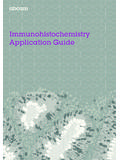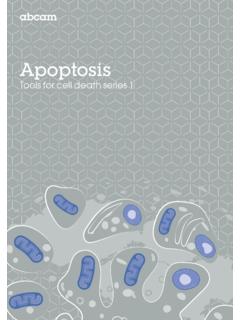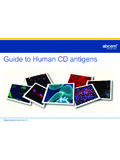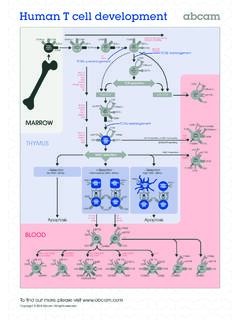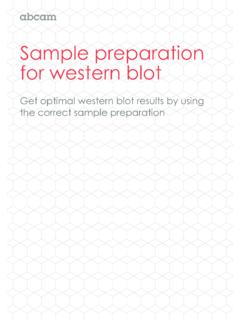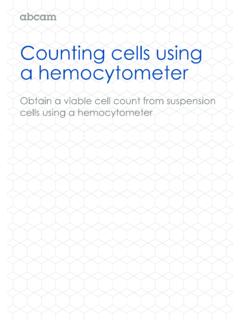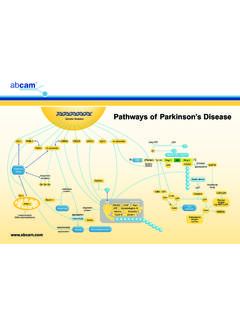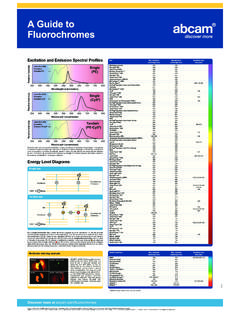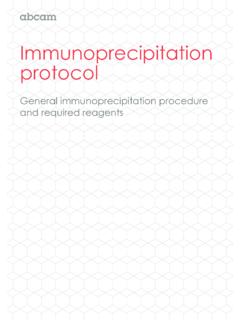Transcription of T Cells the usual subsets - Abcam
1 T Cells : the usual subsets Chen Dong and Gustavo J. Martinez T Cells have important roles in immune responses and function by directly secreting soluble mediators or important for adaptation of immune responses in different microenvironments and might be particularly through cell contact-dependent mechanisms. Many T cell subsets have been characterized. Although relevant for host defence against pathogens that colonize different tissues. Distinct T cell subsets , or effector T Cells were originally considered to be terminally differentiated, a growing body of evidence has differentiation states, can be identified based on the cell surface markers expressed and/or the effector challenged this view and suggested that the phenotype of effector T Cells is not completely fixed but is molecules produced by a particular T cell population.
2 This Poster summarizes our current understanding of more flexible or plastic. T Cells can have mixed' phenotypes (that is, have characteristics usually the surface markers, transcriptional regulators, effector molecules and functions of the different T cell IMMUNOLOGY associated with more than one T cell subset) and can interconvert from one subset phenotype to another, although instructive signalling can lead to long-term fixation of cytokine memory. T cell plasticity can be subsets that participate in immune responses. Further knowledge of how these T cell subsets are regulated and cooperate with each other will provide us with better tools to treat immune-related diseases.
3 Cytotoxic T cell Exhausted T cell Anergic T cell TR1 cell Natural TReg cell NKT cell CD8 T cell Surface TCR, CD3, CD8 Surface CD3, CD8, PD1, Surface TCR, CD3, BTLA Surface TCR, CD3, CD4 Surface phenotype TCR, CD3, CD4, CD25, CTLA4, GITR Surface phenotype , SLAMF1, SLAMF6, TGF R, Surface or TCR, CD3, phenotype phenotype TIM3, 1B11, LAG3 phenotype phenotype Transcription factors FOXP3, STAT5, FOXO1, FOXO3 V 14, J 18 (mouse) phenotype CD8 , B220. Transcription EOMES, T-bet, BLIMP1 Transcription BLIMP1 Effector GRAIL, CBL-B, ITCH, NEDD4 Transcription Not known V 24, J 18 (human) Effector IL-10, TGF . Effector molecules secreted IL-10, TGF , IL-35. factors factors factors factors Transcription PLZF molecules Function Mediate immunosuppression and tolerogenic responses factors secreted Effector Perforin, granzyme, IFN Function Generated in response Function These Cells are generated Effector IL-10 through contact-dependent and -independent molecules to chronic antigen- following TCR activation in molecules mechanisms.
4 These Cells are generated in the thymus. Effector molecules IL-4, IFN , IL-17A Function Intraepithelial lymphocytes secreted mediated TCR the absence of co-stimulatory secreted secreted are found in the gut. They can Function Cytotoxic; kill infected and stimulation. These signals, which leads them Function Can have both pro- and anti-inflammatory develop intra- or extra- Cells express inhibitory to become unresponsive to Function Immunosuppression Inducible TReg cell thymically. They express or transformed Cells and thereby mediated by IL-10 functions. Have been shown to modulate immune protect the host from viral receptors and lack subsequent stimulatory signals.
5 Surface phenotype TCR, CD3, CD4, CD25, CTLA4, GITR responses in several different settings, including TCRs. TCR+ Cells express effector cytokine They are functionally inactive production. These Cells infections and cancer. Direct Transcription factors FOXP3, FOXO1, FOXO3, STAT5, SMAD2, SMAD3, SMAD4 cancer, autoimmunity, allergy, infection and graft- KGF, whereas TCR+ Cells do production; they Cells and fail to proliferate or are generated from naive killing is mediated by secretion of Effector molecules secreted versus-host disease. not. Most TCRs are T Cells in the presence of IL-10, TGF . perforin and granzymes, which therefore fail to mount produce IL-2.
6 Their generation enriched for self-reactivity. TGF and IL-27 or in the Function Promote immunosuppression and tolerance by Other features SAP expression. CD1-restricted TCR. cause apoptosis of target Cells . effective antiviral may be important for avoiding They require 2 microglobulin- presence of the immuno contact-dependent and -independent mechanisms. MAIT Cells express an invariant TCR -chain immune responses. autoimmune responses. dependent MHC class I. Other In humans, mainly CD45RO+. Some suppressive drugs These Cells are generated from naive T Cells in the (V 33J 19 in mice; V 19 in humans). features terminally differentiated CTLs in Other Increased expression of p27 KIP1, expression for their generation vitamin D3 and periphery and, at least in some cases, TGF and IL-2 MAIT Cells are MR1 restricted (not CD1 restricted).
7 Humans re-express CD45RA. features which leads to cell cycle arrest. and/or homeostasis. They can dexamethasone. are important for their differentiation. but have similarities to NKT Cells . have regulatory functions through the production of IL-10 and TGF . 10'0 m TCR CD8 CD4 TCR. CD4. TCR. TCR CTLA4 SLAMF1 TCR. CD3 Cytokine SLAMF6 CD8 . CD8 PD1 TCR receptor CD3 Chemokine GITR CD3 TCR TGF R TCR. TIM3 1B11 receptor CD25 IL-7R CD3. 8'0 m BTLA B220. TCR CD62L LAG3 CD44 CD3 CD3. CD3 CD3. IL-7R CD3. CCR7 CCR7. 6'0 m 4'0 m Naive Cytotoxic Exhausted Anergic Helper Regulatory Memory NKT CD8 . CD4+ T cell TH1 cell TH17 cell Central memory T cell T cell Surface phenotype TCR, CD3, CD4, CCR7, CD62 Lhi, IL-7R (CD127) Surface phenotype TCR, CD3, CD4, IL-12R, IFN R, CXCR3 Surface phenotype TCR, CD3, CD4, IL-23R, CCR6, IL-1R, Surface phenotype CCR7hi, CD44, CD62 Lhi, TCR, CD3, Surface TCR, CD3.
8 CD161 (human only) IL-7R (CD127), IL-15R phenotype Transcription THPOK Transcription factors T-bet, STAT4, STAT1. factors Transcription factors ROR t, STAT3, ROR Transcription factors BCL-6, BCL-6B, MBD2, BMI1 Effector IFN , IL-17A, IL-17F, IL-22. Effector molecules secreted IFN , IL-2, LT . Effector molecules IL-2, CD40L molecules Function Patrol through lymph nodes scanning peptide Function Promote protective immunity against intracellular pathogens. By secreting Effector molecules secreted IL-17A, IL-17F, IL-21, IL-22, CCL20. secreted Low levels IL-4, IFN , IL-17A secreted MHC class II molecule complexes on APCs for IFN , they induce activation of macrophages and upregulation of iNOS, Function Promote protective immunity against extracellular bacteria and fungi, the presence of their cognate antigen.
9 Following Function Preferentially reside in secondary lymphoid Function Enriched at epithelial surfaces leading to the killing of intracellular pathogens such as Leishmania major, mainly at mucosal surfaces. Also promote autoimmune and inflammatory activation by APCs, naive CD4+ T Cells organs, mounting recall responses to and can have both pro- and Listeria monocytogenes and Mycobacterium spp. Their development is diseases. Generated in the presence of TGF and IL-6 and/or IL-21 and are differentiate into effector or regulatory T Cells ; antigens. Even though these Cells lack anti-inflammatory functions, regulated by IL-12. maintained by IL-23 and IL-1.
10 Activated naive T Cells also give rise to memory immediate effector functions, they rapidly depending on the TCR. Other features Also express BATF, I B , IRF4 and AHR transcription factors. Human TH17 Cells and the context. Have T Cells . proliferate and differentiate into effector TH2 cell also produce IL-26. characteristics of both innate Other features CD45RA expressed by human Cells . T Cells following antigen stimulation. Surface phenotype TCR, CD3, CD4, IL-4R, IL-33R, CCR4, IL-17RB, CRTH2 and adaptive immunity. Transcription factors GATA3, STAT6, DEC2, MAF. TH22 cell Effector memory T cell Other IFN - and IL-17A-producing CD8 T cell +. Surface phenotype TCR, CD3, CD4, CCR10 features Cells are distinct populations Surface phenotype TCR, CD3, CD8, CCR7, CD62 Lhi, IL-7R (CD127) Effector molecules secreted IL-4, IL-5, IL-13, IL-10 Surface phenotype CD62 Llow, CD44, TCR, CD3, IL-7R (CD127), Transcription factors AHR that can be distinguished by Function Promote humoral immune responses and host defence against extracellular IL-15R, CCR7low Transcription RUNX3 CD27 and CCR6 expression.
